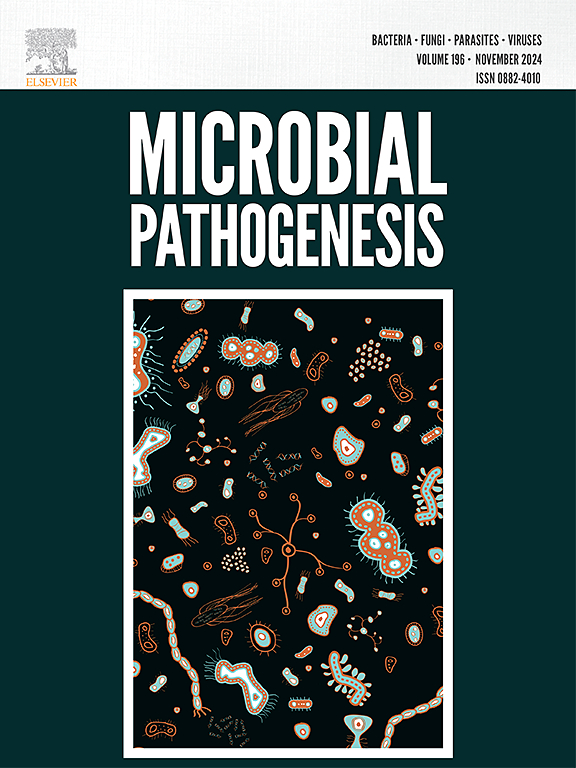Adaptive trade-offs between bacteriophage and antibiotic resistance in Salmonella Typhimurium
IF 3.5
3区 医学
Q3 IMMUNOLOGY
引用次数: 0
Abstract
This study was designed to evaluate the phenotypic properties of PBST35-resistant Salmonella enterica subsp. enterica serovar Typhimurium in association with adaptive trade-offs between bacteriophage resistance and antibiotic resistance. Bacteriophage-insensitive S. enterica Typhimurium (BIST) variants were isolated and analyzed using the spot test, adsorption assay, and biofilm formation assay. The effects of bacteriophage and antibiotic combinations were evaluated using the disk diffusion assay, antibiotic susceptibility assay, and checkerboard assay to evaluate synergy. PBST35 bacteriophage showed a latent period of 10 min, a burst period of 50 min, and a burst size of 72 PFU/CFU. The swimming motility of BIST decreased significantly to 4 %, compared to 70 % in bacteriophage-sensitive S. enterica Typhimurium (BSST). BIST showed increased susceptibility to cefotaxime (CTX), ceftriaxone (CRO), meropenem (MEM), ciprofloxacin (CIP), levofloxacin (LEV), kanamycin (KAN), chloramphenicol (CHL), and sulfamethoxazole/trimethoprim (SXT). The MIC values of CTX, CIP, gentamicin (GEN), and polymyxin B (PMB) against BIST decreased by 2-fold, 1-fold, 2-fold, and 2-fold, respectively. The fractional inhibitory concentration (FIC) indices for BIST were 0.5 for CTX, 1.0 for CIP, 0.5 for GEN, and 0.5 for PMB. The sequential treatment of GEN and PBST35 reduced BSST biofilms by 87 % and BIST biofilms by 68 %. This study provides the potential of combining bacteriophages with antibiotics as a promising strategy to overcome resistance in bacteriophage-resistant strains and supports the development of integrated antimicrobial approaches to combat the growing threat of multidrug-resistant bacterial infections.
鼠伤寒沙门氏菌噬菌体与抗生素耐药性之间的适应性权衡
本研究旨在评估耐pbst35肠沙门氏菌亚种的表型特性。肠炎血清型鼠伤寒菌与噬菌体耐药性和抗生素耐药性之间的适应性权衡相关。采用斑点试验、吸附试验和生物膜形成试验分离并分析了噬菌体不敏感型肠炎鼠伤寒杆菌(BIST)变异株。采用圆盘扩散试验、抗生素敏感性试验和棋盘试验评估噬菌体和抗生素联合使用的效果。PBST35噬菌体潜伏期为10 min,爆发期为50 min,爆发大小为72 PFU/CFU。与噬菌体敏感型肠炎鼠伤寒链球菌(BSST)的70%相比,BIST的游泳运动性显著下降至4%。BIST对头孢噻肟(CTX)、头孢曲松(CRO)、美罗培南(MEM)、环丙沙星(CIP)、左氧氟沙星(LEV)、卡那霉素(KAN)、氯霉素(CHL)和磺胺甲恶唑/甲氧苄啶(SXT)的敏感性增加。CTX、CIP、genamicin (GEN)、polymyxin B (PMB)对BIST的MIC值分别降低2倍、1倍、2倍、2倍。CTX的分数抑制浓度(FIC)指数为0.5,CIP为1.0,GEN为0.5,PMB为0.5。GEN和PBST35的顺序处理使BSST生物膜减少87%,BIST生物膜减少68%。这项研究提供了噬菌体与抗生素结合的潜力,作为克服噬菌体耐药菌株耐药性的一种有前途的策略,并支持开发综合抗菌方法来对抗日益严重的多重耐药细菌感染威胁。
本文章由计算机程序翻译,如有差异,请以英文原文为准。
求助全文
约1分钟内获得全文
求助全文
来源期刊

Microbial pathogenesis
医学-免疫学
CiteScore
7.40
自引率
2.60%
发文量
472
审稿时长
56 days
期刊介绍:
Microbial Pathogenesis publishes original contributions and reviews about the molecular and cellular mechanisms of infectious diseases. It covers microbiology, host-pathogen interaction and immunology related to infectious agents, including bacteria, fungi, viruses and protozoa. It also accepts papers in the field of clinical microbiology, with the exception of case reports.
Research Areas Include:
-Pathogenesis
-Virulence factors
-Host susceptibility or resistance
-Immune mechanisms
-Identification, cloning and sequencing of relevant genes
-Genetic studies
-Viruses, prokaryotic organisms and protozoa
-Microbiota
-Systems biology related to infectious diseases
-Targets for vaccine design (pre-clinical studies)
 求助内容:
求助内容: 应助结果提醒方式:
应助结果提醒方式:


